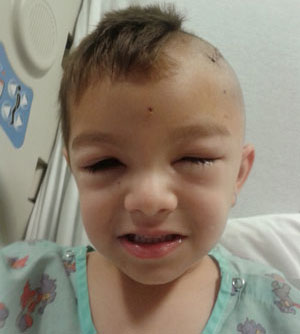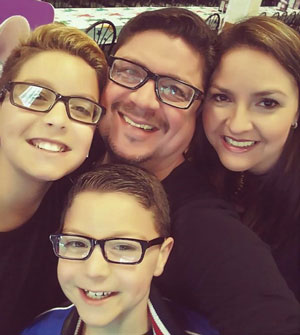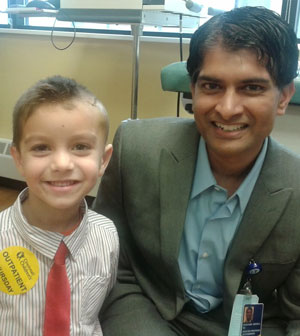Zahid and Moyamoya Surgery
Zahid Mondol was 4 years old in 2013 when symptoms first began to appear: severe headaches and difficulty forming words when speaking.
His parents, Claudia and Abdul, were concerned. Then other signs of potential trouble began popping up, including struggles walking and talking and persistent headache-induced sickness. They didn’t know what was wrong, but they knew Zahid wasn’t his normal self.
After visits to their local pediatrician and hospital near their home in Miami, Zahid was eventually diagnosed with left-sided moyamoya. The family, though, was referred to Cincinnati so that Zahid could be treated by an expert pediatric interventional neurosurgeon.
That’s when they learned about Cincinnati Children’s via their local doctor, who first put the family in touch with the team here in Cincinnati, including Mario Zuccarello, MD, at the University of Cincinnati College of Medicine. Zuccarello then referred the family to pediatric neurosurgeon Sudhakar Vadivelu, DO, director of our Cerebrovascular Disease and Stroke Center.
Shortly after the introduction, Zahid’s family traveled from Miami to Cincinnati to meet with Vadivelu and his team. They knew right away they had made the correct decision to travel 1,000 miles for the specialized care.
“They were wonderful. They talked to us, answered questions and explained everything,” said Claudia.
“I did bring all my folders and all my information and all my questions – like a checklist – because I really wanted to know what is going on and what is happening. I now feel like I have a master’s in moyamoya.”
What Is Moyamoya? Why Cincinnati Children’s?
Well-versed on the rare condition today, Claudia knew nothing about moyamoya back then. Like most parents, she wanted answers to the same questions first raised after receiving a difficult diagnosis: What do I need to know about the condition? What are the treatment options? Who offers the best care and treatment?
In the case of moyamoya, it’s a strange condition with a strange name. The word “moyamoya” in Japanese means “puff of smoke” - alluding to the cloudy nature of the arteries and veins visible in moyamoya patients.
Depending on the patient, the condition develops over the course of months or years. The arteries located at the base of the brain become narrower over time, restricting blood flow to the brain. Without surgical treatment it can lead to several potential problems, including strokes, seizures, permanent weakness and mental decline.
Fortunately for Zahid, he avoided permanent damage thanks to successful brain surgery performed by Vadivelu and his team in December 2013, which involved both direct and indirect revascularization. The surgeries were needed to create new pathways for better blood flow to the brain.
“The only available treatment is surgical, and it’s to reconstruct new blood vessel pathways,” said Vadivelu. “Our whole goal is to restore blood flow to an area of the brain that’s starving for blood supply. To treat that area of the brain that is at risk for stroke before it happens. The odds are heavily against us if we don’t recognize and treat.”
Throughout the process, from pre-surgery discussions until two weeks after surgery when Zahid was discharged, Claudia said she felt like she was part of the care team “more than a 1000 percent.”
“We had an amazing experience. They are an amazing team. We could feel comfortable. We really trusted in them. It’s been a blessing for us to be there,” said Claudia, who was also thankful for our Concierge Services team and the help they provided with appointments, airport transportation and translators.
“Though every patient is unique and requires precision care, Zahid’s parents are similar to a lot of families,” said Vadivelu. “Who are not only looking for care for their child, but they are also looking to understand the process and not just be told what needs to be done.
“And I think that’s one of the big reasons they came here. They saw our number of multidisciplinary providers and at the end of the day felt confident in the process and what needed to be done next. Right away he got the procedure done. And he has done extremely well.”
Years Removed From Surgery, Zahid Doing Well
Today, Zahid is an active 12-year-old who no longer suffers from his prior severe headaches (occasionally he gets a normal headache, but nothing like his former condition). His MRIs have all been good and mostly he feels no different from his friends and fellow classmates.
While he knows he has to be careful not to injure his head, Zahid avoids some activities, but is still able to play most sports and run around like any boy his age.
“Everything has been great. I pretty much live the life of a normal kid, just that I need to be a little more cautious in the things I do,” said Zahid.
At first he was studying karate, but Zahid has since found his true sports passion in soccer. Not only does he play all the time, he’s also a student of the game, eager to learn new facts and stats while watching matches with his father.
"It’s been something that I do a lot and something that I love," said Zahid.
Zahid realizes the dire situation he faced and said he is forever grateful to his family and his team of doctors and nurses for getting him the help he needed, when he needed it.
“I’m very thankful to still be alive. I feel like the doctors gave me a chance to finish my purpose in his world,” he said. “While I’ve been doing well, I’ve given back and I’m trying to do my best in the world to try and impact it as much as they [my doctors] impacted my life."
(Published June 2021)

Zahid smiles following successful surgery performed by pediatric neurosurgeon Sudhakar Vadivelu, DO, and team.

Zahid (pictured top left) with his dad, Abdul; mom, Claudia; and younger brother, Izaak, 8.

Zahid with pediatric neurosurgeon Sudhakar Vadivelu, DO, for a follow-up visit a week after surgery.



